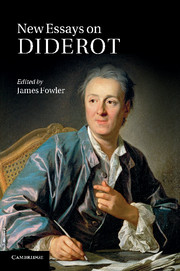Book contents
- Frontmatter
- Contents
- Notes on contributors
- Acknowledgements
- List of abbreviations
- Introduction
- PART I DIDEROT THE PHILOSOPHE
- PART II NOVELS
- PART III DIALOGUES
- PART IV PLAYS AND DRAMATIC THEORY
- PART V MUSIC, PERFORMANCE, AESTHETICS
- 14 Diderot's voice(s): music and reform, from the Querelle des Bouffons to Le Neveu de Rameau
- 15 Diderot and the aesthetics of the libretto
- 16 Ekphrasis and related issues in Diderot's Salons
- Select bibliography
- Index
16 - Ekphrasis and related issues in Diderot's Salons
Published online by Cambridge University Press: 11 April 2011
- Frontmatter
- Contents
- Notes on contributors
- Acknowledgements
- List of abbreviations
- Introduction
- PART I DIDEROT THE PHILOSOPHE
- PART II NOVELS
- PART III DIALOGUES
- PART IV PLAYS AND DRAMATIC THEORY
- PART V MUSIC, PERFORMANCE, AESTHETICS
- 14 Diderot's voice(s): music and reform, from the Querelle des Bouffons to Le Neveu de Rameau
- 15 Diderot and the aesthetics of the libretto
- 16 Ekphrasis and related issues in Diderot's Salons
- Select bibliography
- Index
Summary
Questions of linguistic transparency and opacity have pervaded scholarly discussion about the working of Diderot's ekphrasis. The critical terrain can, broadly speaking, be divided into two approaches. The first consists in a form of detective labour that results in a precise identification of the ‘real’ work of art described by the text. This work is identified as the source of the ekphrasis, which is construed as a transparent linguistic window. For example, in her impressive two-volume study of Diderot and art, Diderot critique d'art (which remains a key reference in Diderot studies), Else Marie Bukdahl writes: ‘À des fins de description, d'interprétation, et de caractérisation des différentes œuvres, [Diderot] a élaboré une représentation impartiale et neutre de la totalité artistique mais aussi quelques procédés poétiques qui s'apparentent à une technique de transposition sur le plan de la langue.’ (‘In order to describe, to interpret and to characterise different works, [Diderot] developed an impartial and neutral representation of the artistic whole as well as certain poetic devices which are similar, at the linguistic level, to a technique of transposition.’)
Diderot is presented here as the inventor of ‘une technique imparable pour capter les événements du visible’ (‘a fail-safe technique for capturing events of the visible’). The impartiality and neutrality of Diderot's work guarantees its fidelity to its object. Even his more ‘poetic’ passages, in which attention risks being drawn to the text's literary rather than its mimetic function, are to be understood as a neutral and faithful transposition into language of the painted image.
- Type
- Chapter
- Information
- New Essays on Diderot , pp. 234 - 247Publisher: Cambridge University PressPrint publication year: 2011

